Beyond wellness for the healthy: Digital health consumer adoption 2018
Utilization of digital health services and technologies has been on the rise since we first began surveying the US adult population in 2015. Budding choices of wearables, apps, telemedicine, and other tech-enabled services make it easy for consumers to test out what it might be like to “go digital” for their health. In the first three years, our annual survey showed that tools for fitness and wellness represented a common (and low-risk) entry point for consumers to experiment with products that fit neatly into their already tech-enabled lifestyles. In the 2018 data that we examined for this report, we saw something different. Consumers continue to go digital and are now doing so not just out of curiosity or for general fitness and well-being—but with the intention to address concrete health needs. More Americans use digital health to manage diagnoses, connect with providers, and make critical healthcare decisions than ever before. While we’re optimistic about this growth and shift in adoption, the 2018 survey also reminds us that these tools often do not reach the populations who stand to benefit the most.
About the survey
2018 was the fourth consecutive year we ran our annual Digital Health Consumer Adoption survey. The survey consists of 4K respondents of US adults age 18 and over. The multi-year longitudinal dataset offers deep insight into consumers’ use and perceptions of digital health over time and is gathered with the intention of supporting those developing, investing in, and implementing digital health solutions to transform the healthcare experience for individuals. Read on for a look at our top insights. For access to all of the trends in the full report—including breakdowns of adoption by demographic groups and more—become a Rock Health partner. Email partnerships@rockhealth.com for more information! For startup access, get in touch by emailing research@rockhealth.com.
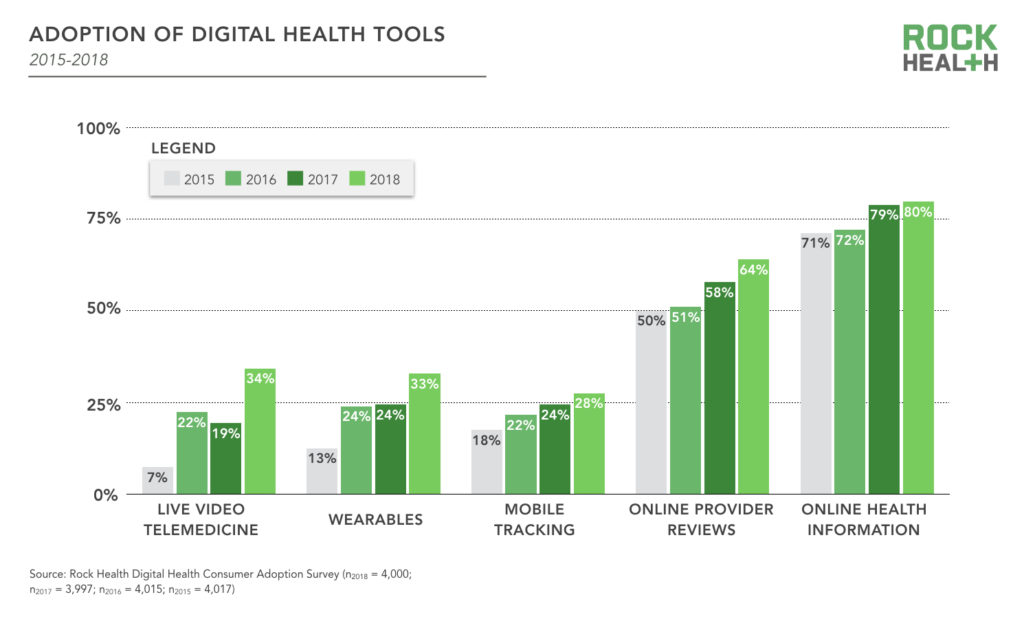
In 2018, respondents adopted digital health tools at a higher rate than ever before. Eighty-nine percent of respondents used at least one digital health tool—up from 80% in 2015. Live video telemedicine and wearable adoption rates surged following a pause in growth in 2017. Meanwhile, respondents were increasingly guarded about their personal health data—in 2018, respondents were less willing to share data with highly-trusted entities like providers and insurance companies compared to 2017.
Insight 1: Wearable use is shifting away from fitness toward managing health conditions
In 2018 the tides of wearable usage changed dramatically—respondents reported using wearables to manage a diagnosis and using them less to motivate a physically active lifestyle.
Monitoring physical activity remains the top reason for wearable use, but only 44% of wearable owners cited physical activity as the top reason for their wearable use, down from 54% in 2017. This 10% decrease is mirrored by a 10% increase in respondents using a wearable to manage a diagnosis. Wearables are morphing from their original fitness and wellness label into a tracker that can be clinically meaningful to patients—and perhaps even providers.
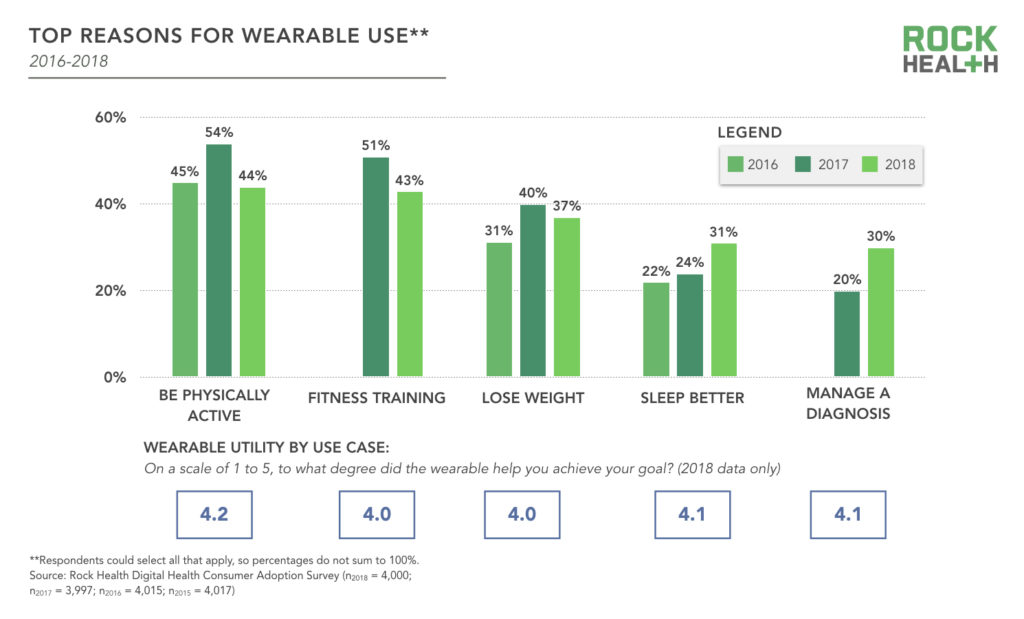
The transition from fitness to healthcare hasn’t been without bumps in the road—Jawbone fell from unicorn to deadpool status following a failed pivot from consumer to clinical services. Fitbit is in the midst of its own clinical pivot, and faces growing competition from the likes of Apple and Samsung.
It’s therefore worth noting that discontinued wearable use still plagues the sector—many a step tracker sits at the bottom of a drawer. In 2018, 39% of wearable users stopped using their wearable, marking a substantial jump from 27% in 2017. This is significant—the number of respondents who stopped using a wearable in 2018 was larger than the increase in respondents who adopted a wearable from 2017 to 2018. Nonetheless, we suspect wearable use will become stickier as the shift from fitness to clinical uses continues, as providers get more value from data to monitor patients, and as consumers are incented to sustain use.
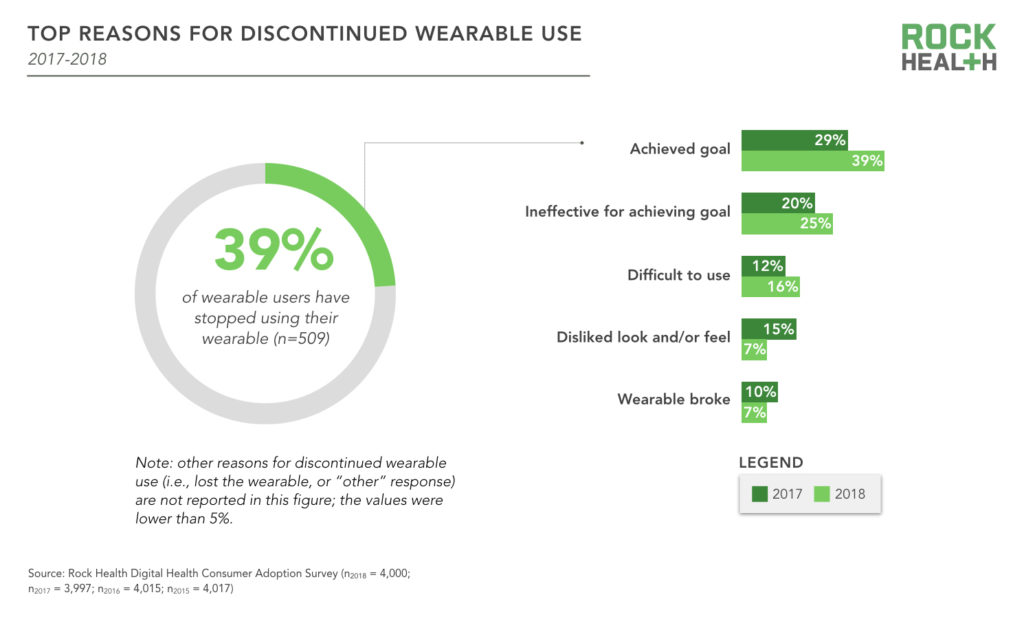
For instance, risk-bearing entities are beginning to explore ways to empower patients to monitor their own health indicators. Most recently, Aetna teamed up with Apple to allow its members to purchase an Apple Watch and then “earn it back” through healthy behavior. It’s a partnership that brings to life two major forces in healthcare today—value-based care and consumerism. Some payers and employers hope that investment in wearable devices and fitness programs will pay off through improved patient outcomes.
Investors are also betting on the future of digital health companies leveraging wearables. Since 2011, $3.4B has been invested into these companies—11% of all digital health venture dollars across that time period1. This activity has been steady over the past few years, with 30 to 40 funding deals every year since 2014.
Insight 2: Telemedicine adoption is climbing, with urban consumers more than twice as likely to use live video telemedicine than rural consumers
Adoption rates for telemedicine surged in 2018, with 75% of consumers using at least one channel to access remote care—up from 68% in 2017. Despite the potential for telemedicine to extend healthcare access to consumers in rural areas, rural respondents utilized these services far less frequently than urban respondents. Adoption of at least one form of telemedicine was 67% for rural residents and 80% for urban residents.
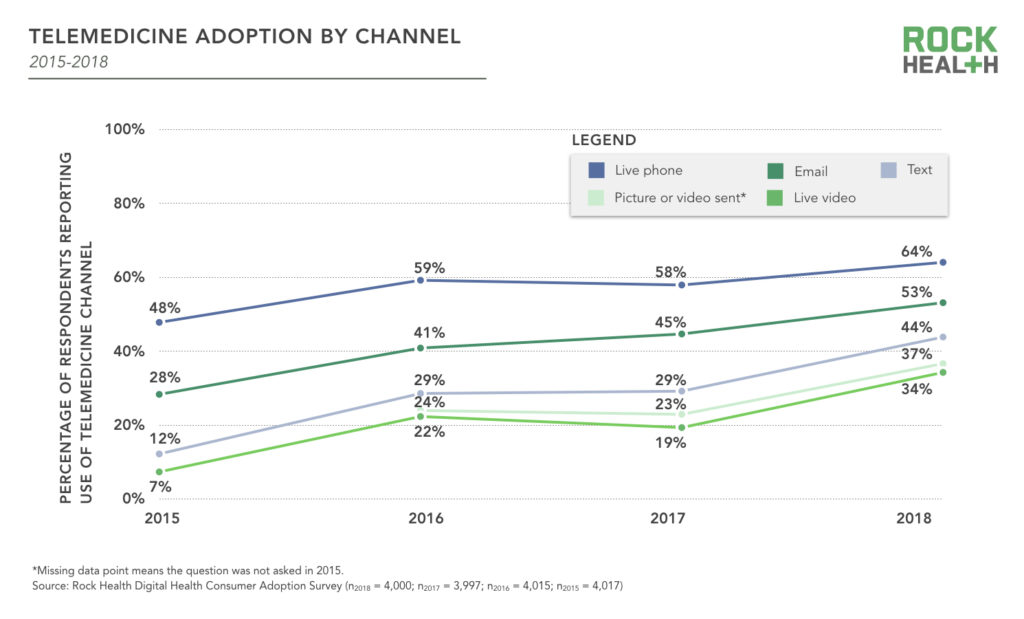
Growth in live video telemedicine has been particularly strong, increasing six-fold in just three years. But at 34%, the high rate of live video telemedicine adoption is a composite that masks stark disparities—22% of rural consumers accessed care through live video versus 51% of urban consumers. The older, rural consumer population is being left behind. Only 17% of rural respondents aged 35+ utilized video telemedicine in 2018—19 percentage points less than rural respondents aged 18 to 34, and 29 percentage points less than urban residents aged 35+. Perhaps this outcome isn’t too surprising—just a quick glance at the marketing of well-funded, telemedicine-based startups makes it clear that they are targeting tech-savvy millennials seeking the same convenience with their healthcare as they do with their take out (see Roman Health, Hims, The Pill Club, Nurx, Lemonaid).
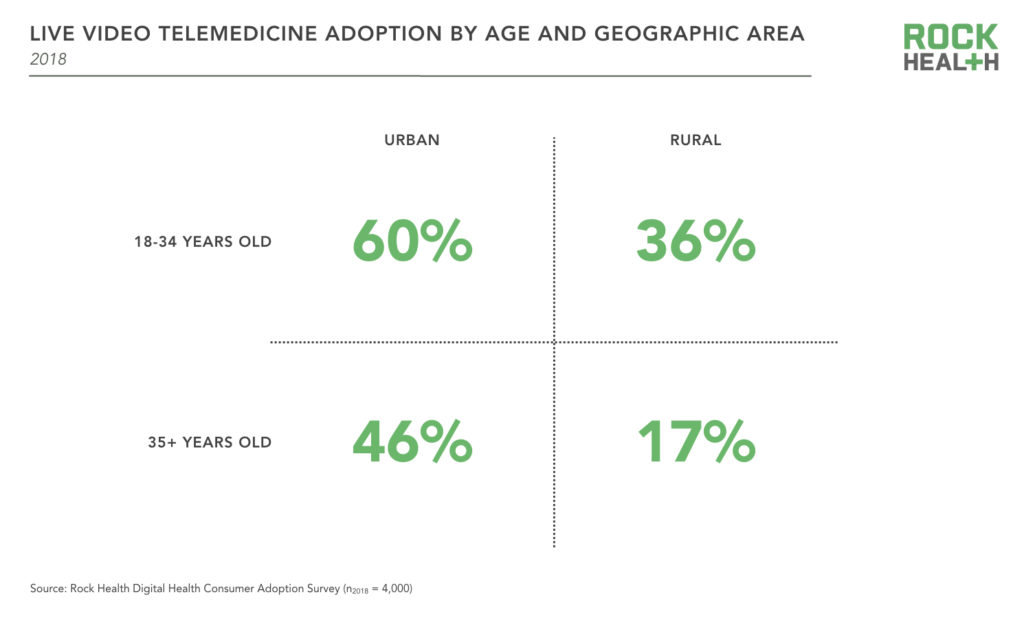
Despite the uneven adoption, it was a big year for telemedicine in the US. The rise in adoption rates followed passage of the CHRONIC Care Act in February of 2018. The measure extends telemedicine coverage to patients in Medicare Advantage plans and accountable care organizations. With an increasingly clear reimbursement pathway, investors opened the funding spigot—$1.3B was invested in telemedicine startups in 2018, a massive three-fold increase over the $450M invested in 2017. In addition to big fundraising rounds—American Well raised $291M and Doctor on Demand raised $74M as both seek to expand their growing footprints—we saw a trend towards consolidation. American Well acquired Avizia, InTouch acquired Reach Health, and Teladoc acquired Advance Medical. And a new breed of care providers like Oscar and CareMore Health, which we refer to as “next generation payers and providers (NGPPs),” are making telemedicine a core component of new patient-centric care models.
Insight 3: Highly trusted entities like physicians and health plans lost credibility in 2018—consumers were less willing to share data with them than they were in 2017
As in past years, respondents in 2018 were most willing to share their personal health data with physicians, health insurance companies, pharmacies, and research institutions. Respondents also reported the most trust in the data security of these entities—but the overall trend is not in their favor. On average, these four most trusted entities lost 8.8% of respondents willing to share their health data between 2017 and 2018.
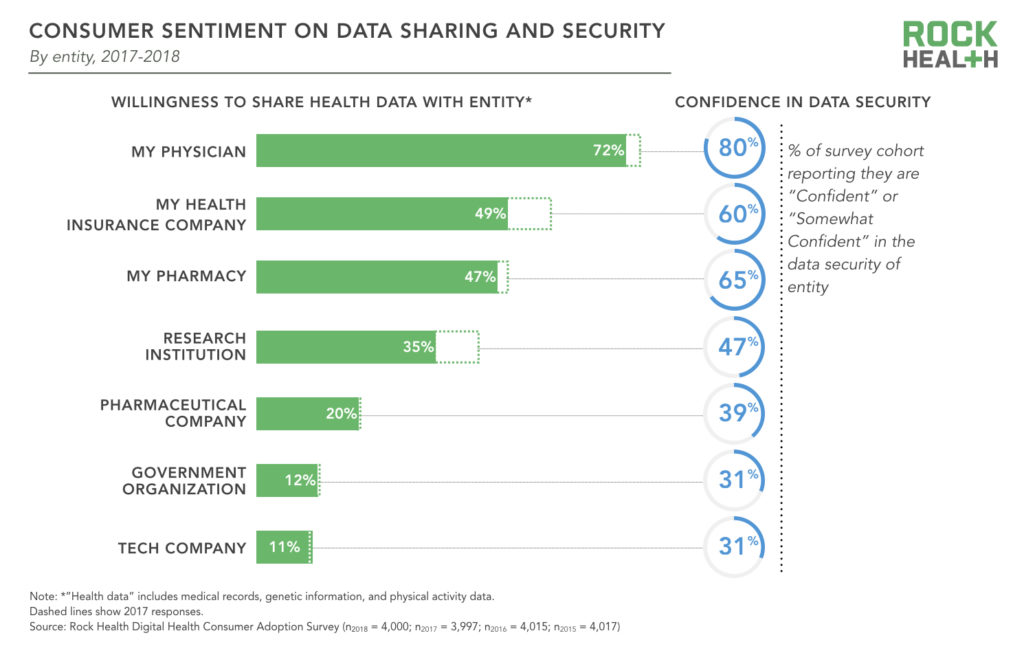
One explanation is shifting public sentiment around data privacy and security following the Cambridge Analytica and other tech company scandals. Distrust of big tech likely impacts the healthcare industry. For instance, Anne Wojcicki, CEO of the direct-to-consumer genetic testing company 23andMe, blamed broad privacy concerns spilling over from other sectors for the company’s slow growth in 2018. And high profile incidents like Anthem’s 2015 breach, for which it paid a $16M settlement to the federal government, don’t reassure consumers that their health information is safe once digitized.
Consumers remain wary about sharing their health data with technology companies—only 11% of respondents were willing to share with a tech company. Google was the most trusted company of those in the survey, with 60% of respondents willing to share their health data with a tech company willing to do so with the search giant (remember: this means only 7% of total respondents were willing to share with Google). Facebook, unsurprisingly given the negative press coverage, ranked near the bottom with only 40% willing to share health data with the social network. It is unclear how consumers’ unwillingness to share health data will hinder the growing number of tech companies making healthcare plays.
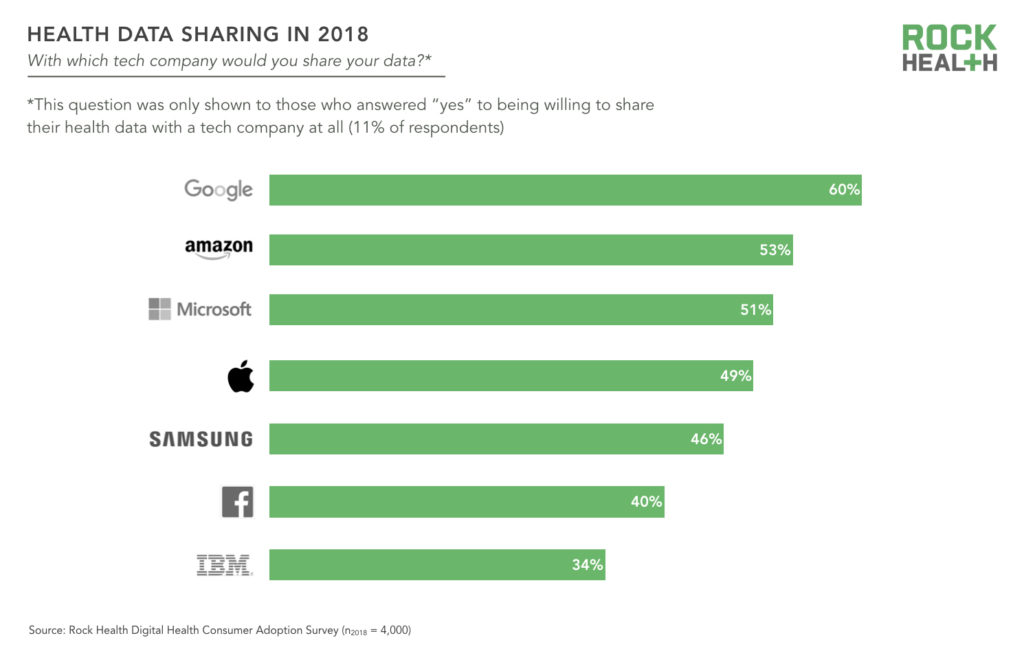
If we look to big tech as a leading indicator, it appears new regulation may be on the horizon. But we don’t know if and how that would impact the healthcare industry. And consumers’ actions don’t necessarily mirror their sentiments—Facebook recorded a record profit in Q4 2018 and its user base continued to grow during a year in which it was chastened by the public and policymakers. We’re eager to continue engaging in this important conversation regarding data privacy, data security, and consumer trust in digital health. Here’s a handful of questions we want to explore further—let us know what you’re interested in at research@rockhealth.com!
- Do consumers understand where and for what their health data is shared?
- How does consumers’ willingness to share health data compare with other types of personal data?
- Do consumers trust algorithms to make healthcare decisions based on their data?
We’ll continue tracking trends in consumer attitudes and adoption of digital health services with our 2019 survey later this year. If you’d like to learn more about the survey—and access the full data set—become a Rock Health partner! Please email partnerships@rockhealth.com to learn more. We also encourage academics and startups to connect with us to access our research. For more information, please email research@rockhealth.com.
Join us this spring for the Rock Health Enterprise Insights Series, which brings together the healthcare innovation ecosystem to help enterprise leaders navigate their most pressing business challenges. These curated events—starting in Boston, DC, and NYC—feature the latest market insights from Rock Health research, facilitated networking opportunities, and strategies for overcoming barriers to innovation. Learn more and sign up for updates.
Footnotes
1 Source: Rock Health Funding Database. Only includes U.S. deals >$2M.

